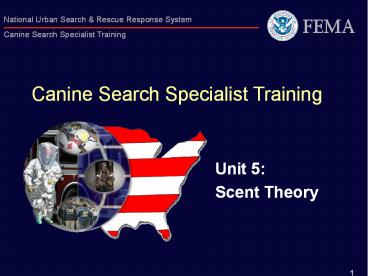THEORY OF SCENT and SCENT TRANSPORT - PowerPoint PPT Presentation
Title:
THEORY OF SCENT and SCENT TRANSPORT
Description:
Canine Search Specialist Training Unit 5: Scent Theory * This scent cone represents an open area, with consistent wind speed and direction. Cells + bacterial activity ... – PowerPoint PPT presentation
Number of Views:130
Avg rating:3.0/5.0
Title: THEORY OF SCENT and SCENT TRANSPORT
1
Canine Search Specialist Training
Unit 5 Scent Theory
2
3
Unit Objective
- Upon completion of this unit, you will be able to
explain the theory of scent as it relates to the
canine search for live victims in a collapsed
structure
4
Enabling Objectives
- Explain the rationale for understanding scent
movement - Describe the factors that may affect scent
- Describe how scent is transported away from the
victim - Plan the search of a collapsed structure to
efficiently work canines into scent
5
Rationale
- Dogs see the world through their nose
- Scent is 3-dimensional to them
- Our job is to put them where they can best detect
scent
6
(No Transcript)
7
The Canine
Olfactory System
8
The Nose Knows
9
Canine Olfactory System
- Olfactory sensory cell estimates
- Human 5 million
- Canine 220 million
10
CONTRIBUTORS TO HUMAN SCENT COMPLEX
Adipose
Bacterial Action
MEOH H2SO4 Volatile Fatty Acids
K, Cl, Urea, Ca Mg, PO4, HOH
Human Scent
Sebaceous
Eccrine
Sebum, Squalene
Volatile Fatty Acids Amines
Respiratory Tract GI Tract
Apocrine
Other factors Genetic, Diet, Environment
11
Huh?
12
What is scent to a canine?
13
The Raft Theory
- Dying/dead, bacteria laden skin cellscalled
rafts - Rafts are shed from
- Skin
- Respiratory and digestive tracks
14
Skin raft loss
- Approximately
- 40,000 per minute!
15
- If one gram of butyric acid was made to
evaporate evenly in all the rooms of a ten story
office building, a man would barely be able to
perceive its existence by standing in one of the
rooms. However, if the same gram of butyric acid
was diluted to fill the air above the entire city
of Hamburg, the dog could still perceive it at an
altitude of 300 feet. - William Syrotuck
- Scent and the Scenting Dog, pg. 13
16
How is scent dispersed?
- The scent is heaviest at the source and dispersed
away from the victim in a cone
17
Scent Dispersal
18
Influences on Scent Dispersal
19
Environmental Influences
20
Environmental Influences
- Temperature
- Wind strength and direction
- Humidity
- Sun
21
(No Transcript)
22
Temperature
- Hot
- Cold
- The temperature of victim versus the temperature
of the environment
23
Wind
- Strength
- Direction
24
Humidity
- High
- Low
- Rain
25
Sun
- Clear
- Overcast
- Night
26
Day-time Patterns
Night-time Flows
27
Structural Influences
28
Structural Influences
- Building architecture
- Elevator shafts
- Closed stairwells
- Windows
- Breached floors/walls
29
Structural Influences (continued)
- Scent flows well in
- Broken rubble
- Light framing
- Brick
30
Katrina 2005
31
Scent Flow and Detection
32
Scent Flow and Detection
- The disaster search canine is trained to indicate
the presence of a live victim by performing a
focused bark alert at the point in the rubble
where the strongest live human scent is emitted
Bark! Bark!
33
DETECTION versus LOCATION
- Dogs are SCENT detectors NOT victim locators!
34
Scent FlowChanneling
BARK
scent cone
scent cone
scent cone
- Solid Slabs
- Large Chunks
35
- Solid Slabs
- Large Chunks
BARK
BARK
36
Scent Source Detection
- Be able to interpret your dogs alert
- Document
- Debrief
- Handler to STM
- Handler to Handler
37
Scent FlowFunneling
Bark! Bark!
38
Scent FlowPooling
Bark! Bark!
39
Typical Collapse Patterns
- Lean-To
- V
- Pancake
- Cantilever
40
Lean-To
41
(No Transcript)
42
V
43
Pancake
44
(No Transcript)
45
Cantilever
46
(No Transcript)
47
What is this?
Cold Wall
Hot Wall
48
Use your scent knowledge
- Identify scenting conditions
- Surveyors tape, puff bottles/talc mirror scent
pattern - Interpret pattern of alerts
- Send canine from position which maximizes
probability of detection
49
Considerations
- Hazardous materials
- Live versus dead
- Number of victims found
- Distractions
50
Questions?
51
Scent Theory/Air Movement Demonstration
52
Unit Summary and Evaluation
53
Unit Summary
- Explain the rationale for understanding scent
movement - Describe the factors that may affect scent
- Describe how scent is transported away from the
victim - Plan the search of a collapsed structure to
efficiently work canines into scent
54
Unit Evaluation
- Please fill out the evaluation on this briefing

